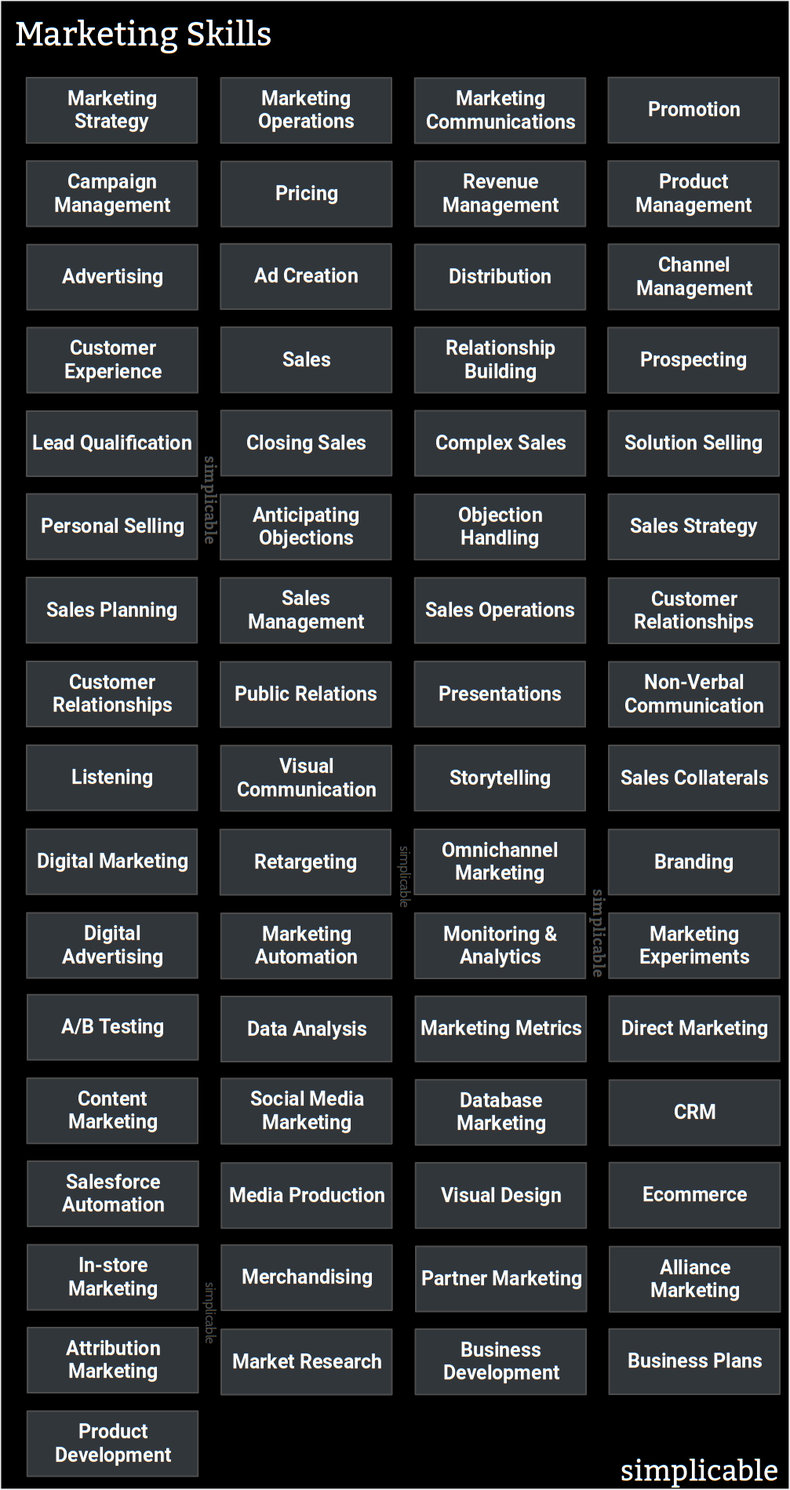
Marketing Strategy
Developing marketing goals, strategy and plans.Marketing Operations
Administration of the end-to-end marketing process including elements such as sales and operations planning.Marketing Communications
Marketing communications includes marketing areas that are focused on communication including branding, public relations, promotion and product launches.Promotion
Generating demand and brand awareness with promotion techniques.Campaign Management
The planning and execution of coordinated marketing campaigns that may include operations, distribution, promotion, pricing and branding. For example, an ice cream manufacturer who ramps up production and promotion to support a summer price cut.Pricing
The process of setting prices based on factors such as stock levels, demand and competition.Revenue Management
Revenue management is the complex process of pricing and promoting inventory that expires at a point in time such as seat on a flight or night in a hotel room. Also known as yield management.Product Management
Managing products and services through their entire lifecycle from launch to retirement.Advertising
A promotion technique that involves paying for access to a target audience.Ad Creation
Developing ads themselves. A highly creative process that is often outsourced to an advertising agency.Distribution
Distribution is the process of reaching the customer to sell to them and deliver your products and services.Channel Management
Managing your sales and marketing channels including channel partners.Customer Experience
The end-to-end delivery of your services considering every touchpoint with the customer.Sales
The process of engaging customers and closing sales.Relationship Building
The ability to establish and sustain positive relationships with customers, partners and other stakeholders.Prospecting
Prospecting is the process of developing sales leads.Lead Qualification
The practice of scoring leads to decide which leads to prioritize and which to discard.Closing Sales
The art of getting to yes to close sales.Complex Sales
High value sales that involve multiple decision makers and long selling cycles.Solution Selling
Developing unique products and services for each customer as opposed to selling them something out-of-the-box. For example, selling software that is highly customized for each customer.Personal Selling
Selling person-to-person.Anticipating Objections
Predicting reasons why customers will rationalize against buying your products and services to plan to defeat these objections.Objection Handling
Responding to customer objections to close sales.Sales Strategy
The process of developing sales strategy.Sales Planning
Planning resources to achieve sales strategy.Sales Management
The day-to-day process of directing sales teams and controlling resources such as budget.Sales Operations
The administration of the end-to-end sales process including lead generation, lead qualification, opportunities, needs analysis, proposals, contracts, deal approval, order fulfillment, customer service and customer retention.Customer Relationships
The process of building relationships with customers to ensure customer satisfaction. This is essential to your reputation and customer lifetime value.Customer Service
Customer service is the process of engaging the customer to meet their needs.Public Relations
Managing the reputation of a firm and communications with all stakeholders including investors, employees, communities, customers, regulators and partners.Presentations
The process of communicating to customers and other stakeholders such as the media.Non-Verbal Communication
Elements of communication that are beyond words such as eye contact and body language.Listening
Listening with focus and intent to understand.Visual Communication
Communicating information and emotion with visuals.Storytelling
Storytelling is the ability to make information interesting.Sales Collaterals
Developing materials to support sales processes. For example, presentations, product brochures and price lists.Digital Marketing
The use of technology to reach customers including digital advertising, social media marketing and certain types of direct marketing such as email marketing.Retargeting
The use of digital advertising to target a customer after they have performed some action. For example, showing ads to a customer who recently visited your website.Omnichannel Marketing
Optimizing your marketing across all your channels.Branding
Developing a valuable identity for your products and services in a crowded market. Branding is mostly focused on brand recognition, brand awareness and brand image.Digital Advertising
The purchasing, optimization and monitoring of digital ads.Marketing Automation
Using software to automate or semi-automatic marketing.Monitoring & Analytics
Monitoring the results of your marketing efforts with tools such as analytics.Marketing Experiments
Testing things to optimize your campaigns. For example, testing hundreds of variations of a digital ad to optimize an advertising campaign.A/B Testing
A simple type of experiment that compares two variations. A/B testing is a common way to optimize for marketing goals such as an improved conversion rate.Data Analysis
Data analysis is the systematic processing of data to build information assets, solve problems and support decisions.Marketing Metrics
The ability to calculate and use marketing metrics to improve results.Direct Marketing
Any marketing that directly reaches out to the customer to promote products and services. This can include various channels such as digital advertising, email, mail, telephone and person-to-person selling.Content Marketing
The production of content such as videos and photos to draw customers so that you can pitch to them.Social Media Marketing
The use of social media for content marketing and direct marketing.Database Marketing
The use of databases to identify potential customers and tailor messages for them.Customer Relationship Management
Customer Relationship Management, or CRM, is a category of software that is commonly used to track prospects, opportunities, customers, sales, orders and other data that is critical to marketing.Salesforce Automation
A category of software that is commonly used to track end-to-end sales processes, customers, orders and sales analytics. Comparable in functionality to CRM.Media Production
The production of media such as audio, video and interactive environments.Visual Design
The design of visual elements such as websites, signs, product packaging and advertisements.Ecommerce
Knowledge of ecommerce platforms and skills related to ecommerce promotion, selling and operations.In-store Marketing
Operating retail locations including in-store promotion and merchandising.Merchandising
Merchandising is the presentation of goods and services in retail locations, product showrooms and other locations such as trade fairs.Partner Marketing
Developing marketing partnerships in areas such as distribution and promotion.Alliance Marketing
Alliance marketing is another term for partner marketing that is applied to a wide range of strategic partnerships such as co-branding and licensing.Attribution Marketing
Attribution marketing is the practice of modeling the events that lead to desired customer actions such as a purchase.Market Research
Researching market conditions including customers and the competition.Business Development
Growing a business in new strategic directions. For example, entering a new market.Business Plans
Developing a formal proposal for a strategy or investment including an analysis of opportunity, risk, cost and return on investment.Product Development
Developing new products and services and improving existing offerings.| Overview: Marketing Skills | ||
Type | ||
Definition | Abilities, talents and knowledge related to marketing, sales and related areas such as product development. | |
Related Concepts | ||








































